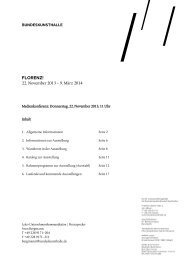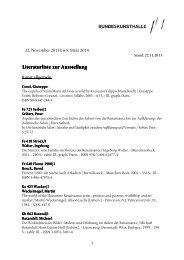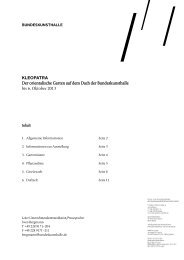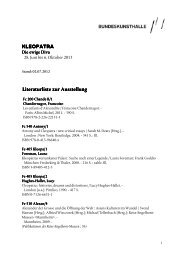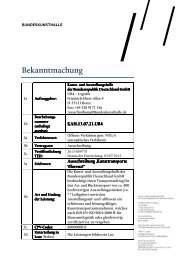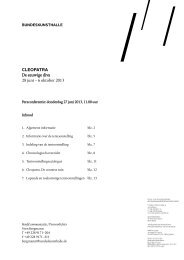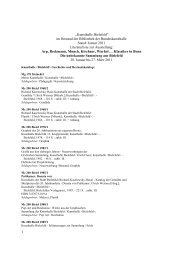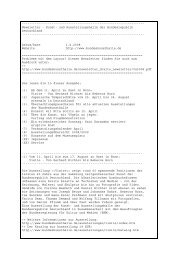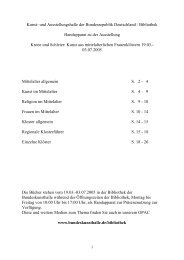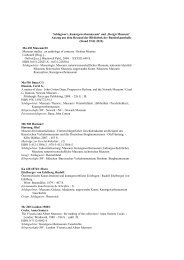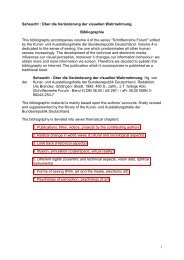Peoples through space and time Archaeology in Germany 09.05 ...
Peoples through space and time Archaeology in Germany 09.05 ...
Peoples through space and time Archaeology in Germany 09.05 ...
You also want an ePaper? Increase the reach of your titles
YUMPU automatically turns print PDFs into web optimized ePapers that Google loves.
geographers dedicated themselves to exam<strong>in</strong><strong>in</strong>g the history of this village from its establishment <strong>in</strong> the 12 th<br />
century to recent <strong>time</strong>s.<br />
Castles <strong>and</strong> Fortresses<br />
Research <strong>in</strong>to castles <strong>and</strong> fortresses goes back to the 19 th century. For years it was undertaken primarily<br />
by historical associations <strong>and</strong> <strong>in</strong>terested laypersons.<br />
Up until the 1970s, Medieval archaeology still took little notice of fortresses as they were hardly<br />
threatened by modern construction measures. It was not until later that castles <strong>and</strong> fortresses began to<br />
attract greater attention among archaeologists.<br />
However, questions perta<strong>in</strong><strong>in</strong>g to these facilities’ construction history <strong>and</strong> their importance to the<br />
history of settlements, to the arm<strong>in</strong>g of its residents, <strong>and</strong> to everyday life can only be answered <strong>in</strong><br />
cooperation with specialists from various fields, such as archaeologists, art historians, build<strong>in</strong>g<br />
historians <strong>and</strong> natural scientists.<br />
Early Bells<br />
As a means of measur<strong>in</strong>g <strong>time</strong>, bells became <strong>in</strong>creas<strong>in</strong>gly important s<strong>in</strong>ce Charlemagne (768-814) <strong>in</strong><br />
connection with the ecclesiastical organization of the Frankish Empire. Bell r<strong>in</strong>gs summoned the faithful<br />
to mass <strong>and</strong> determ<strong>in</strong>e the every day rhythm of life. Cadenced r<strong>in</strong>g<strong>in</strong>g <strong>in</strong> cloisters <strong>and</strong> churches also<br />
served as a means to spread news as of the 9 th century.<br />
Yet no bells have been completely recovered from this period. Archaeological research has often<br />
uncovered traces of bell cast<strong>in</strong>gs. Because of difficulties <strong>in</strong> transport, travel<strong>in</strong>g craftsmen made bells <strong>in</strong><br />
direct proximity to the site where they were to hang later. If important cast<strong>in</strong>g parts, the oven or even<br />
the bell are preserved, then ideally a re-cast<strong>in</strong>g is possible.<br />
Jewish Culture<br />
The most recent archaeological exam<strong>in</strong>ations of Jewish ghettos have made an important contribution to<br />
Medieval urban topography <strong>and</strong> to social <strong>and</strong> cultural history.<br />
The build<strong>in</strong>g history of synagogues <strong>in</strong> the centrally located Jewish quarters is characterized by<br />
destruction <strong>and</strong> reconstruction, which, <strong>in</strong> the Christian Middle Ages, is also reflected <strong>in</strong> the persecution<br />
<strong>and</strong> destruction that marks the history of the Jewish people <strong>in</strong> <strong>Germany</strong>.<br />
The Jewish Quarter <strong>in</strong> Regensburg<br />
Excavations on the Neupfarrplatz <strong>in</strong> the old city of Regensburg produced valuable <strong>in</strong>formation on the<br />
Jewish quarter, destroyed <strong>in</strong> 1519, which <strong>in</strong>cluded a Gothic synagogue that was known to us only<br />
<strong>through</strong> two etch<strong>in</strong>gs by Albrecht Altdorfer.<br />
Archaeological exam<strong>in</strong>ations uncovered not only numerous cellar vaults but also the rema<strong>in</strong>s of the<br />
synagogue’s Romanesque predecessor, which was destroyed <strong>in</strong> a fire <strong>in</strong> the 13 th century.<br />
The Jewish community’s good economic position <strong>in</strong> Medieval Regensburg is exemplified by the<br />
synagogue’s <strong>and</strong> private houses’ solid architecture as well as by three recently discovered co<strong>in</strong> hoards.<br />
The last hoard to be salvaged, buried <strong>in</strong> the course of the ‘Great War of Cities’ <strong>in</strong> 1388, conta<strong>in</strong>ed 624<br />
gold co<strong>in</strong>s.<br />
The Genisa of Veitshöchheim<br />
In the course of renovation work on the Veitshöchheim synagogue attic near Würzburg, a<br />
comprehensive collection of religious <strong>and</strong> worldly works form the 17 th to 19 th century were found<br />
underneath the floorboards <strong>and</strong> beh<strong>in</strong>d the walls.<br />
Besides bibles, prayer books, <strong>and</strong> Rabb<strong>in</strong>ical texts there are folk tales <strong>and</strong> historical texts, <strong>in</strong> larger<br />
numbers also h<strong>and</strong>written documents such as <strong>in</strong>voices <strong>and</strong> letters, which had been taken out of service.<br />
Accord<strong>in</strong>g to Jewish regulation they were not allowed to be thrown away <strong>and</strong> thus were preserved. The<br />
stock of writ<strong>in</strong>gs comprises a so-called Genisa, which is also known from other old synagogues.<br />
The Veitshöchheim Genisa is unique <strong>in</strong> that it is comprehensive. Study<strong>in</strong>g the works provide an <strong>in</strong>depth<br />
view to the faith <strong>and</strong> culture of this Jewish rural community.<br />
26




